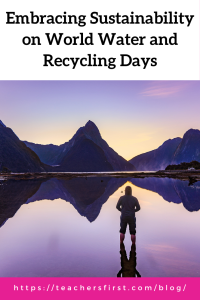The environment is where we all meet; where all have a mutual interest; it is the one thing all of us share. It is not only a mirror of ourselves, but a focusing lens on what we can become.
Lady Bird Johnson
Lady Bird Johnson’s wisdom reverberates as we near World Recycling Day on March 18 and World Water Day on March 22. These moments offer educators valuable chances to underscore the significance of sustainability and environmental stewardship within their classrooms. In this post, we’ll explore how to integrate conservation themes into your classroom instruction.
Engaging with the SDGs through Interactive Learning:
Sustainable Development Goals (SDGs) were adopted by United Nations members in 2013 and offer an outline for obtaining peace and prosperity throughout the globe. Goals address poverty, equity, and climate action, but the four key components are people, planet, prosperity, peace and partnership. Introducing the SDGs to our students doesn’t have to be daunting. Resources like The World’s Largest Lesson provide educators with a springboard of ideas to incorporate SDGs into the curriculum. But if you’re not sure where to start, here are some Sustainable Development Goals (SDGs) aligned with different grade levels:
SDG 3: Good Health and Well-being
K–2 – Primary students can learn the importance of staying healthy, eating nutritious foods, and practicing good hygiene. They can then create a health and well-being poster or a healthy food collage. Have students share their creations and thoughts on platforms like Seesaw (reviewed here) or Padlet (reviewed here).
SDG 12: Responsible Consumption and Production
3–5 – Intermediate students can take what they learn about reducing waste, recycling, and making environmentally conscious choices and create environmental impact presentations. They can have the option to research different products or practices and their environmental impact, such as single-use plastics, fast fashion, or food waste. Using presentation creation tools like Canva (reviewed here) or Google Slides (reviewed here), they can create presentations to share their findings with their classmates and the school community.
SDG 7: Affordable and Clean Energy
6–8 – Middle level students can create comic strips of renewable energy sources (solar, wind, hydroelectric, geothermal, etc.). Using Free Comic Strip Maker (reviewed here) or Free ComicMaker.com (reviewed here), students can create a comic strip that illustrates the process of harnessing the energy source they’ve researched, explaining its benefits and applications. Each panel can depict different stages of energy production, from generation to distribution, and students can add any relevant captions to help readers grasp the concept!
SDG 11: Sustainable Cities and Communities
9–12 – High school students can engage in a Socratic Seminar to explore urban planning, sustainable transportation, and the role of communities in building resilient cities. Through guided discussion, students can investigate the complexities of sustainability within urban environments together. Socratic Seminars are great for complex topics like this because they can foster critical thinking and deepen understanding. This can also drive students to advocate for positive change in their own communities.
Exploring Water Conservation with Digital Simulations:
For World Water Day, immerse your students in the world of water conservation through digital simulations! Platforms like PhET Interactive Simulations (reviewed here) offer interactive simulations that allow students to explore water scarcity, water pollution, and sustainable water management practices. After doing digital simulations for World Water Day, students can apply their newfound knowledge in several ways. They can think about what they learned and how it affects water in the world and have an interactive discussion on Flip (reviewed here) or as a class using Thinking Routines. They can also do research to learn more and share what they find with others, creating more awareness in their school and community.
In celebration of World Recycling Day, facilitate a recycling pledge activity that is simple yet impactful for students of all ages. As a class, create a large recycling pledge board or mural where students can write or draw their commitments to recycle more, reduce waste, and protect the environment. Encourage students to visit the pledge board and add their contributions throughout the day. You can then share this pledge with your school community and invite them to add to the pledge board. This activity raises awareness about the importance of recycling and empowers students to take ownership of their environmental actions in a positive and inclusive way.
Integrating sustainability into classrooms empowers students to be stewards of our planet! I invite you to share your thoughts and ideas on how we can further incorporate sustainability efforts into classrooms. Your insights and experiences contribute to the collective effort towards a more sustainable future! Please feel free to leave your comments below and join the conversation!


